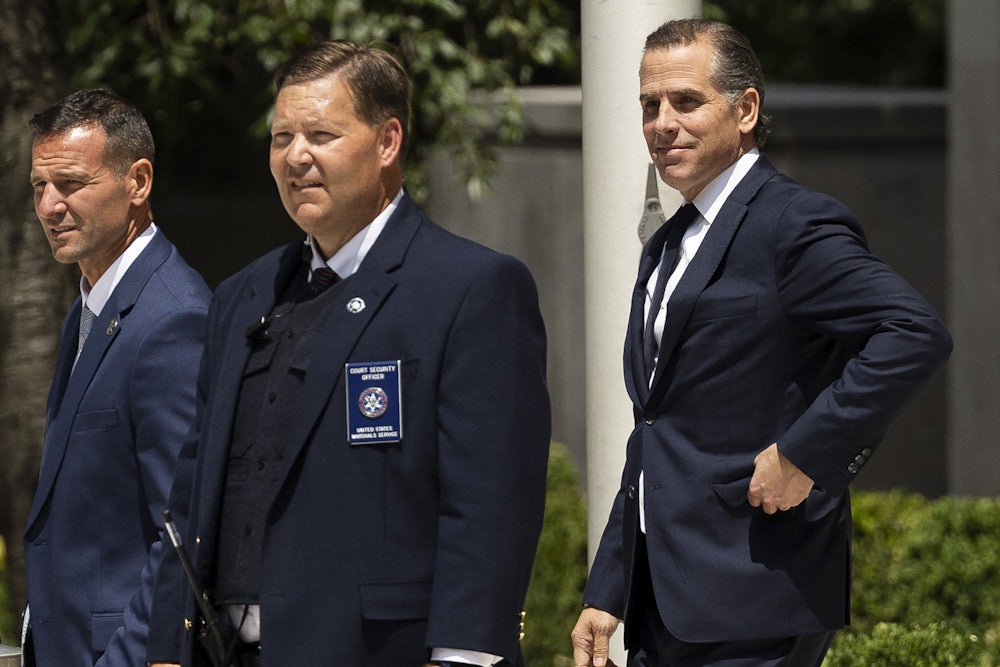Last year, the Supreme Court made it harder for Congress and state legislatures to pass laws that restrict when Americans can own and carry guns. It instituted a new history-and-tradition test in New York Rifle and Pistol Association v. Bruen that lower courts have already used to overturn various gun control laws. President Joe Biden is among Bruen’s critics, having said he was “deeply disappointed” by the court’s ruling last summer.
“Since 1911, the State of New York has required individuals who would like to carry a concealed weapon in public to show a need to do so for the purpose of self-defense and to acquire a license,” Biden said then. “More than a century later, the United States Supreme Court has chosen to strike down New York’s long-established authority to protect its citizens. This ruling contradicts both common sense and the Constitution, and should deeply trouble us all.”
The president may now have at least some reason to think the ruling is less troubling: It could ultimately save his son from federal prosecutors. On Thursday, the Justice Department charged Hunter Biden with three counts of violating federal gun laws. According to the indictment, Hunter faces one count of illegal possession of a firearm while under the influence of an illegal drug and two counts of making false statements about his drug use when purchasing the firearm in question in 2018.
Bruen focused on New York’s regime for issuing concealed-carry licenses, which had been criticized for its selective application and its discriminatory effects. It was the first major Second Amendment case the high court heard in more than a decade. In the 2008 case District of Columbia v. Heller, the justices held that the Second Amendment protects an individual right to bear arms. McDonald v. Chicago, a follow-up case decided in 2010, applied Heller’s reasoning to state and local governments as well.
In the 12 years that followed, lower courts continued to uphold nearly all gun regulations that faced legal challenges from gun owners and Second Amendment groups. Bruen changed that dynamic by imposing a stricter test for lower courts to use when deciding whether particular gun laws pass constitutional muster. Justice Clarence Thomas, writing for the majority, laid out a history-and-tradition test that reflected the conservative majority’s commitment to originalism.
“When the Second Amendment’s plain text covers an individual’s conduct, the Constitution presumptively protects that conduct,” Thomas wrote. “The government must then justify its regulation by demonstrating that it is consistent with the Nation’s historical tradition of firearm regulation. Only then may a court conclude that the individual’s conduct falls outside the Second Amendment’s unqualified command.”
Lower courts have since used this test to strike down a variety of long-standing gun laws. The Supreme Court will hear oral arguments later this fall in United States v. Rahimi, where the Fifth Circuit Court of Appeals used Bruen to strike down a federal law that prohibits gun ownership by people under domestic violence restraining orders. The Fifth Circuit panel noted that there was no evidence that early American legislatures passed similar laws, meaning that it did not meet the history-and-tradition standard. That American society did not recognize domestic violence as a major societal issue until after women obtained the legal and civil rights they often lacked in the founding era did not matter.
Hunter’s case revolves around a provision known as Section 922(g)(3), which makes it illegal for someone to own a firearm if they are an “unlawful user” of a controlled substance. This ban applies even if the person is not under the influence when they actually buy, carry, or use a gun. Since American legislatures did not criminalize drug use until the late nineteenth and early twentieth century, there is good reason to believe 922(g)(3) is no longer constitutional in a post-Bruen world. Indeed, at least one federal court has already reached that exact conclusion.
In August, the Fifth Circuit Court of Appeals ruled in United States v. Daniels that a 922(g)(3) conviction had failed Bruen’s history-and-tradition test and therefore violated the Second Amendment. The government had convicted Patrick Daniels, the defendant in that case, for violating the provision based on his admission that he used marijuana from time to time each month. But prosecutors did not show that he was under the influence of marijuana or any other controlled substance when he was arrested or even when he had last used them.
Judge Jerry Smith, writing for the unanimous three-judge panel, concluded that federal prosecutors had not provided sufficient historical evidence to justify upholding 922(g)(3). He acknowledged that an exact founding-era analogue was unlikely because the founding generation had a different relationship with marijuana than modern Americans. (Hemp was often used to make rope in the early nineteenth century, and, Smith noted, George Washington cultivated it at Mount Vernon.) But states also did not enact gun restrictions similar to 922(g)(3) for other addictive or intoxicating substances like alcohol, which was seen as a much greater vice in that era.
“Throughout American history, laws have regulated the combination of guns and intoxicating substances,” Smith wrote. “But at no point in the 18th or 19th century did the government disarm individuals who used drugs or alcohol at one time from possessing guns at another. A few states banned carrying a weapon while actively under the influence, but those statutes did not emerge until well after the Civil War. Section 922(g)(3)—the first federal law of its kind—was not enacted until 1968, nearly two centuries after the Second Amendment was adopted.”
The panel’s ruling was ultimately narrow, Smith concluded. “We do not invalidate the statute in all its applications, but, importantly, only as applied to Daniels,” he wrote. “Nor do we suggest that a robust Second Amendment is incompatible with other reasonable gun regulations.” But the ruling also rested on a fairly rigid interpretation of Bruen’s test. By rejecting on various grounds the alcohol-related analogues the government offered, it all but guaranteed that no such historical tradition would be found.
The Fifth Circuit is neither the first nor the last court to address this question. Federal district courts in Oklahoma and Texas have reached separate but similar conclusions about 922(g)(3)’s constitutionality over the past year, while some federal courts in other jurisdictions have upheld the provision since Bruen. Last month, for example, a federal judge in Iowa explicitly declined to adopt the Fifth Circuit’s interpretation itself.
“This narrow reading and demand for near perfect analogues—despite acknowledging Bruen’s pronouncement analogues need not be perfect—is too severe,” Judge C.J. Williams wrote in a ruling on a pretrial motion, referring to the Fifth Circuit’s ruling, “and places too great an emphasis on the specific controlled substance Daniels used—marijuana—when Section 922(g)(3) regulates unlawful users and addicts of any controlled substance, not specific controlled substances.”
What happens next is not clear. Another federal appeals court upholding the provision as constitutional could prompt the Supreme Court to intervene to resolve the circuit split. The various lower court rulings may also be affected by the high court’s decision in Rahimi in the upcoming term, especially if the justices refine or alter the history-and-tradition test for Second Amendment cases. And while Hunter’s lawyers may opt to challenge this case on constitutional grounds, they have already argued against its lawfulness for other reasons that may succeed without reaching this precise constitutional question.
For now, the only thing that is certain is that the Justice Department filed charges against the president’s son under a gun control statute of questionable constitutionality in the middle of a post-Bruen revolution in Second Amendment case law. Joe Biden’s critics often accuse him of waging a war on law-abiding Americans’ right to bear arms. If you had told those critics one year ago who the most prominent target of this war would be, they probably wouldn’t have believed you.










